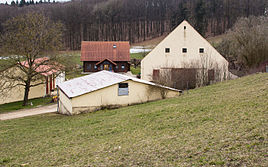Kohlhof (Heidenheim)
|
Kohlhof
Heidenheim market
Coordinates: 49 ° 1 ′ 18 ″ N , 10 ° 43 ′ 4 ″ E
|
||
|---|---|---|
| Height : | 595 m above sea level NN | |
| Residents : | 2 (Jun 30, 2011) | |
| Postal code : | 91719 | |
| Area code : | 09833 | |
|
Location of Kohlhof in Bavaria |
||
|
Kohlhof
|
||
The Kohlhof ( ) is a district of the Markt Heidenheim in the central Franconian district of Weißenburg-Gunzenhausen ( Bavaria ).
location
The Kohlhof is located in the Franconian Alb north-west of Heidenheim in a hollow high above the Rohrachtal on the eastern flank of the Rechenberg . State road 2218 passes to the east and north . From here branches branch off to the Kohlhof.
Place name interpretation
"Kohlhof" is interpreted as the "courtyard to the mountain where (wood) coals are burned".
history
The settlement "Kohlhof" belongs to an area that has been called Kyrsenloch / Kirschenlohe since ancient times and consisted of several individual farms belonging to the Heidenheim monastery (1732: Kohlhof, Gärtnershof , Kirschenmühle , Krämershof and Obelshof ). A source from the middle of the 12th century, which is available in a copy from the 15th century, reports that a relative of a canon gave the Heidenheim monastery an estate "Coleberch". In the 13th century, Friedrich and his son Otto von Truhendingen gave the Heidenheim monastery, among other things, possessions of "Colberch"; In 1275 Otto's two brothers named Friedrich von Truhendingen agreed to this donation. The "Kolpaur" had to pay taxes in cash and in kind, especially grain, to the monastery, but around 1400 he had his property "free and his own", so under the lower jurisdiction was not subject to a bailiff, but only to the monastery itself Secularization of the monastery (1537) the Kohlhof was subordinate to the Brandenburg monastery office in Heidenheim and belonged to the Hohentrüdingen neck court . In 1616 the Kohlhof is vogtable and valid for the monastery office Heidenheim.
The Kohlbauer was killed in 1634 during the Thirty Years' War . After the war, Balthasar Heidinger, an exile from Upper Austria, was a farmer on the Kohlhof for a short time . Until the end of the Holy Roman Empire , the Kohlhof remained with the Heidenheim administration office, while the high court was held by the margravial Oberamt Hohentrüdingen. Ecclesiastically, the place was assigned to the Protestant parish of Heidenheim.
The wasteland that became royal- Prussian with the margraviate of Ansbach in 1792 became royal-Bavarian as a result of the Reichsdeputation Hauptschluss in 1806. When tax districts were formed in 1808 , the Kohlhof came to the Heidenheim tax district in the Heidenheim district court with other wastelands and mills, which were subject to interest from the property of the former Heidenheim monastery . Two years later, the tax district became the somewhat smaller rural community of Heidenheim, to which the Kohlhof also belonged. By the community edict of 1818, Heidenheim was again a community in the district court of the same name in 1808. In 1833 the Kohlhof consisted of 26.6 hectares of arable land, 5.8 hectares of meadows and 11.4 hectares of forest.
On July 1, 1862, the district court of Heidenheim became part of the district office (later the district) of Gunzenhausen , which was transformed into the larger district of Weißenburg-Gunzenhausen during the regional reform in Bavaria in 1971/72.
Population numbers
- 1818: 7 inhabitants
- 1824: 6 inhabitants, 1 building
- 1837: 5 residents, 2 families, 1 residential building
- 1867: 6 inhabitants, 2 buildings
- 1950: 9 inhabitants, 1 building
- 1961: 8 residents, 1 residential building
- 1979: 8 inhabitants
- 1987: 2 inhabitants
- June 30, 2011: 2 residents
literature
- J. Heyberger and others: Topographical-statistical manual of the Kingdom of Bavaria with an alphabetical local dictionary. Munich 1867, column 1038.
- Hanns Hubert Hofmann: Historical Atlas of Bavaria, Franconia Series I, Issue 8: Gunzenhausen-Weissenburg. Munich 1960, especially p. 235.
- Official city directory for Bavaria 1964 with statistical information from the 1961 census. Munich 1964, column 785.
- Robert Schuh: Gunzenhausen. Former district of Gunzenhausen . Series of Historical Place Name Book of Bavaria. Middle Franconia, Volume 5: Gunzenhausen. Munich: Commission for bayer. Landesgeschichte 1979, especially No. 150, pp. 160f.
- 1250 years Heidenheim am Hahnenkamm. Heidenheim: Historical Association 2002.
- Martin Winter: From the Kohlhof near Heidenheim . In: Alt-Gunzenhausen 57 (2002), pp. 82-87.
Individual evidence
- ↑ a b Schuh, p. 161
- ↑ a b 1250 years Heidenheim, p. 38
- ↑ 1250 years Heidenheim, p. 40; Winter, p. 86
- ↑ This section essentially based on: Schuh, pp. 160f.
- ↑ Winter, p. 86
- ↑ 1250 years Heidenheim, p. 263
- ↑ Historical Atlas, p. 135
- ↑ a b c d Historical Atlas, p. 235
- ↑ Historical Atlas, p. 223
- ↑ Heyberger, Col. 1038
- ↑ Official Directory of places, Col. 785
- ↑ Schuh, p. 160
- ↑ according to the Bavarian municipal parts file
- ^ Website of the Heidenheim market


